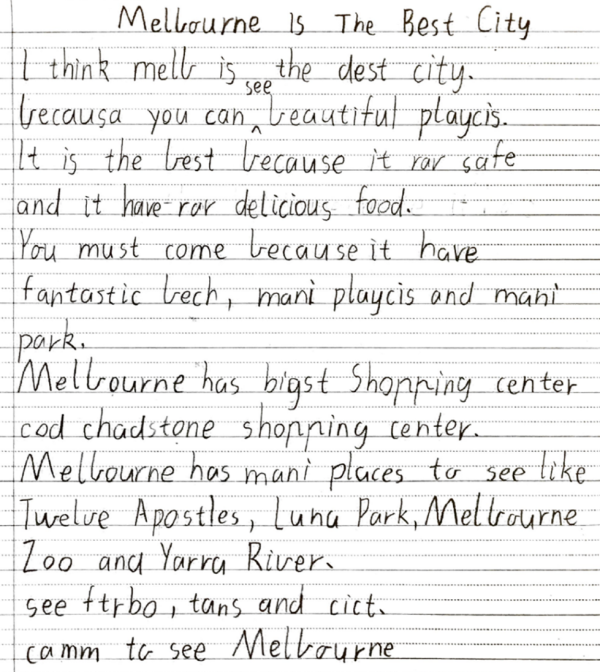Student information
The student is 9 years old and in Year 4. He was born in China and speaks Mandarin. He has had age-equivalent schooling and is able to read and write in his home language. He has been studying in an English language school for over four terms due to the impact from the COVID-19 pandemic in 2020. His parents have very little English and therefore are unable to provide a lot of support at home.
Task
Students have been learning about Australia including the states and territories, capital cities and places of interest. Students also looked at voicing opinions (agree and disagree) and supporting their opinions with reasons. For this task, students were given the topic as their opinion and asked to write a text to persuade their friends or family to come and visit Melbourne. The class had explored the structure of a persuasive text prior to writing. Key vocabulary were provided on flash cards with pictures.
The student completed the task independently using the flashcards and text structure discussed.
The analysis is based on the student’s writing before correction.

Text
Melbourne Is The Best City
I think melb is the dest city.
becausa you can see beautiful playcis.
It is the best because it rar safe and it have rar delicious food.
You must come because it have fantastic bech, mani playcis and mani park.
Melbourne has bigst Shopping center cod chadstone shopping center.
Melbourne has mani places to see like Twelve Apostles, Luna Park, Melbourne Zoo and Yarra River.
see ftrbo, tans and cict.
camm to see Melbourne
This sample of student work demonstrates that the student can:
- Create short, simple texts for particular purposes, with some support and modelling (VCEALA300)
- Organise some subject matter and write according to the structure of the text type, using modelled forms and repetitive patterns (VCEALL307)
- Use a small range of simple descriptive phrases (VCEALL312) *uses simple noun phrases such as delicious food, beautiful playcis, bigst Shopping center, fantastic bech
- Use some conjunctions to connect ideas within a sentence (VCEALL313) *uses because through modelled sentence structures
- Use formulaic structures (VCEALL314)
- Spell accurately common words encountered in the classroom (VCEALL318)
Overall, this student can also:
- Write simple imaginative or personal texts modelled on familiar forms and repetitive patterns (VCEALC298)
- Engage with a range of writing tasks (VCEALA306)
Possible next steps for this student's learning
- Proofreading and editing own work for spelling mistakes and/or errors, with teacher support (VCEALA302)
- Participating in a range of spelling activities focused on common letter patterns based on words that are commonly misspelt (VCEALA304)
- Using the TEEL (Topic sentence, Explanation, Evidence and Linking sentence) framework to plan the main ideas for writing, then using a writing template with the same framework to structure own writing (VCEALL308)
- Using a checklist to support consistent use of punctuation such as capital letters for proper nouns and at the start of a sentence, and full stops at the end (VCEALL319)
Pathways and transitions considerations
A Year 4 student working within the range of Level B1 in any one language mode is not ready to transition to the English curriculum regardless of their proficiency in the other two language modes. This student will continue on Pathway B of the EAL curriculum in all language modes.